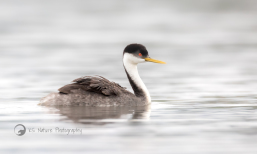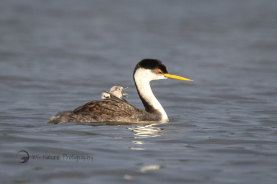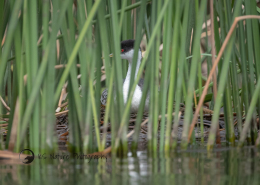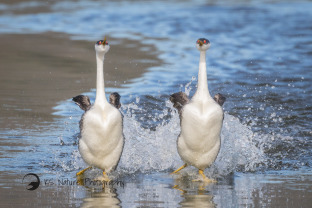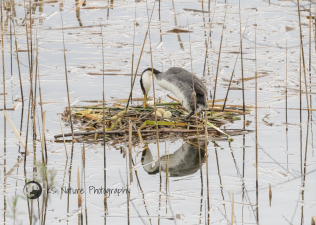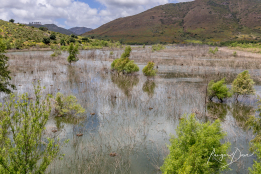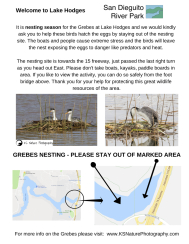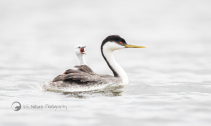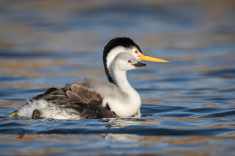Grebe Conservation Program
Latest on the Grebes at Lake Hodges - March 2023:
We had a wonderful first part of 2022 at the Lake and a few very productive meetings with the San Diego Audubon Conservation Committee and City of San Diego and we continue to work together. The Grebes did not nest the winter season, due to the water levels lowered 20-35FT in May 2022 for work done by the City on the dam. Originally the work was to be completed by October 2022, which now has been pushed to late spring of 2023. The Lake is all dried up on the east side and there is less wildlife activity also. You can read more about the City Project HERE.
October 25, 2022 - WE DID IT!!
Super thrilled to receive first place in category: Photography: serious subject at the San Diego Press Club's Excellence in Journalism Awards for my Grebe photos accompanying the article "The Grebes of Lake Hodges and their complicated quest to nest". I was honored to be able to contribute my Grebe expertise and photos to the article and a huge thanks to the talented LaTeresa Pearson for her brilliant writing. Oh and we also took first place in Wildlife/Nature category. A great win for the Grebes, the San Diego Audubon Society, and my Grebe conservation project at Lake Hodges, CA.
Update on the Grebes at Lake Hodges - September 28 2021
The chicks are growing up and as cute as ever! This was a great nesting, unplanned and great numbers, 40 pairs with chicks out of 70 some nests we counted back in July 2021. Here are a few shots for you. For the full story please do scroll down the page.
You can download the official report I did with the San Diego Audubon Conservation Committee on the nesting success here:
Adobe Acrobat document [509.3 KB]
Grebe Update from Lake Hodges
August 28, 2021
23 pairs with at least one chick
12 had at least 2 chicks
and the remaining 5 have between 3-4. Yes there is one at least with 4 chicks (yes we got photo!)
If that did not happen there would have been a few eggs to hatch, but overall well done! We can for sure do better next time and as a member of the San Diego Audubon Conservation Commitee we will be working with the City and Biologist to make all this even better!
HUGE SUCCESS! They are here!
August 22, 2021
LATEST UPDATES - August 15, 2021
Very happy to report that the Grebes are doing FANTASTIC! at Lake Hodges CA! Lots of nests, about 70 on two sites and water levels are holding! There is a very slight drop dues to natural evaporation (mother nature doing it's thing in 100F weather) but not to worry, these nests were build in the light vegetation so as Grebes nests do, they move up and down with water level fluctuation. Grebes are busy attending to eggs, adding on to nest and just waiting as we all do. Incubation is 25 days and first nests were spotted back on July 28th, with some already having eggs.
Cross your fngers - we are only about 1-6 days away from some super cute chick sightings!!!
As a member of the Conservation Committee for the San Diego Audubon Society I am just super proud of the work we have accomplished this past year. Go Grebes!
UPDATES - JULY 2021
PROJECT BACKGROUND
Western and Clark's Grebes are arguably the birds most readily associated with Lake Hodges. They are visible year around in great numbers. Grebes mainly eat fish, catching them by diving in open water. Both species have dramatic, choreographed courtship display, in which the birds rush across the water together. These large, elegant black and white water birds breed here in the winter months. During mating season they engage in a maneuver called rushing, in which they sprint up to 50 feet across the water in coordinated groups of two or more in about seven seconds.
** Please note that all photos of nesting Grebes and nests were taken from an ethical and safe distance, from the trail, with long telephoto lens and heavy crop. Nobody should enter nesting areas on a boat.
PROJECT OVERVIEW
The purpose of our continuing project is to document the varied behaviors of the Western and Clarks Grebes that inhabit the waters of Lake Hodges in San Diego County and work on a plan with the City of San Diego to save the Grebe nests. Because the waters are a result of a purpose-built reservoir for drinking water it is important to understand these behaviors in order to liaise with the public utilities department that owns the lake on ways to effectively manage the water levels during breeding season.
For the past few years the lake has been home to hundreds of nesting grebes. Once a migratory visitor to the lake in the winter these birds have now taken up permanent residence on the lake. The population of the colony has increased steadily over the past years, this in combination with the ease of access to the lake by both shoreline and boat has made Lake Hodges an eco destination for viewing the Grebes.
The problem concerning the grebes in the past couple of years has occurred when San Diego County receives measurable amounts of rainfall in short periods of time that cause the lake to fill into the shallow mud flat areas. Southern California historically does not receive these types of rains until the winter and into spring, about the same time the grebes on the lake are preparing for nesting. The flooding of these areas that are normally dry and full of wetland plants become prime habitat for nesting and when it becomes available the Grebes take full advantage and start to nest which is done as a colony.
The public utilities department is mandated by the State of California to keep the reservoir at a maintenance level due to the safety of the dam. Because there has been no management plan in place in previous years to address the nesting grebes during these water influxes the lowering of the water levels by the Public Utilities Department has resulted in nest failures throughout the colony, which in turn has caused public outcry.
PROBLEM SOLVING
We have an ongoing project to document the varied behaviors of the Western and Clarks Grebes that inhabit the waters of Lake Hodges and to work on a plan with the City of San Diego Public Utilities Department to preserve Grebe nests. Because the waters are a result of a purpose-built reservoir for drinking water it is important to understand these behaviors in order to liaise with the public utilities department that own the lake on ways to effectively manage the water levels during breeding season.
We have been on the forefront for many years now in talking with the public and government agencies involved on how to address this problem and come to a workable solution that would benefit both the water department and the grebe colony.
Using our photographical documentation along with observational data metrics collected with the grebes throughout the years we have created informational flyers that specify were nesting sites are and have historically been and what to look for in order to better help boaters and other users understand their potential impacts to these sites. These flyers have been done in coordination with the outlying open space agency and lake staff.
We have created and lead workshops on grebe behavior at the lake, independently and as part of San Diego’s bird festival for the past four years. This also enables us to bring awareness about the Grebes to many of the local Audubon chapters and photography clubs through a series of informational presentations.
THE LATEST UPDATES (January 2020)
Mid August of 2019 we were asked to be an official liaison with the City of San Diego. We were working together with the City to help form a management plan that will hopefully be ready by next nesting season. We are also working with City of San Diego biologists to assist in providing observational data and to help create an observational data recording protocol. The data collected throughout the year gives the Public Utilities Department an idea of the Grebe colony behavior and helps identify when and if they will nest thus avoiding a situation like we had in 2019.
Currently Lake Hodges is at its maintenance level and will more than likely be at this level for some years to come. This level wavers above and below the habitat line that the grebes have used in past years to nest. Our early predictions for this year are that the colony will not nest though they will as always go through all the steps it takes to get to that point. That being said the season is not over yet and this tenacious water bird may yet find some suitable nesting habitat somewhere around the lake. It may take some time for the tulles/reeds around the lake shore to grow enough to provide any viable nesting habitat for the colony as a whole but with the lake at a constant level with any luck it should happen.
Update April 11, 2020
Because of recent heavy rainfall the City of San Diego began to release 923million gallons of water, to keep the lake the the 295ft level as planned. The release will take about a week and we will see where water levels end up. Read the official news release HERE.
To be honest, we are very concerned that the slow release will be an issue here and we did express that to the City. We really feel that this area should never be let to have water again, being so shallow, the city is not ready to properly manage the levels, so second best choice is that encourage the Grebes to find other areas.
Update April 20, 2020
We had a nice chat with the City of San Diego Biologist at Lake Hodges a couple days ago. We've been monitoring as the water slowly left and levels were going down. I really wish the city would of let the water out faster! Lots of Grebes already moved to this area, we just need to wait and see where the water levels settle in. More updates next few days.
Update April 29, 2020
Conservation is an uphill battle. And today with a broken heart I am sharing with you some very sad news: this past few days over 200 Grebe nests, many with eggs, were lost again at Lake Hodges CA.
Please read on for the full story: A little background: If you follow our Grebe conservation efforts at Lake Hodges, you know it had it’s ups and downs. You may have heard about an incident last year (2019) regarding water levels after a major rain and how the lack of protocol within the City of San Diego Public Utilities Department caused the Grebe nesting site to collapse. Public outcry forced the City to take action to prevent this in the future. Along with City biologist we were asked "to assist in providing observational data and to help create an observational data recording protocol. The data collected throughout the year gives the Public Utilities Department an idea of the Grebe colony behavior and helps identify when and if they will nest thus avoiding a situation like we had in 2019."
So we did – and things were going well! The lake levels stabilized and the Grebes were happy. We were in contact with the Biologist and we had big hopes. Before rain events, the City let water out so with rain the lake filled up and water was kept at a stable level. Things were going good.
However two weeks ago a major rain event arrived and in one week San Diego County received about 6" of rain. This obviously flooded the old nesting site again, taking the water levels over the mandate and we all knew the water cannot be sustained at that level because of the old dam. Within 24 hours of the rain event hundreds of grebes moved into the area to nest. This time the City did NOT drop the lake levels prior to the rain. Why not?
We advised the City months prior that the grebes were more than ready to nest and that they were on the hunt for nesting sites. Once the old nesting site gets flooded, things will happen FAST. We knew that and let the City know also. Per the mandate, levels must be kept at 290-295feet and we are OK with that, it is actually better for the Grebes. So the rain came, nests were built and breeding began immediately after the rain event. Within days the City announced that they would be draining the lake according to mandate and should take about a week.
And this is when we worried and emailed, called and reached out, again.
The slow water drop REALLY concerned us. Why? Because Grebes MOVE fast. At this point again we informed the City over and over that they MUST let that water out fast. One week is pushing it, drop should be fast so the Grebes won't get excited about a nesting site that we all know won't be viable (since water levels are mandated to be under 295ft).
During that first week the colony breeding site went from 50 to 100 to over 150 nests some already showing that they had eggs. The quickness that the colony reacted was an amazing site to behold. The city at that time was advised that the colony was growing quicker than the water was being let out and that there was potential of a colony collapse. As we told the biologist "the race was on". We were told the water was not at the mandated level yet and draining would continue. That's fine we said but please do it faster.
The second week the colony jumped from around 150 nests to over 200 with some nests now showing an elevated height due to the continuation of the dropping water level. Many of the nests were showing eggs and the parents were engaged in turning them to keep them cool during the warm temps. On Friday the 24th it was clear to us that the water was still slowly going down.
Things were not looking good for the grebes and we felt a disastrous outcome was about to unfold. But maybe just maybe the city would react accordingly and now stop the draining to preserve the nesting site. On Monday April 27th it was clear that the city was continuing to drain water off of the lake a full week after they said they would be done. At this point the colony was starting to abandon nests. We again advised the city and even pleaded with them that at this point it is better to stop draining or face a complete collapse of the colony breeding site.
The response we got made our heart drop. It was clear that the city was focused on reaching the mandated water level at whatever speed they wanted to and no discussion
about the conservation of the grebes was even hinted to. The next morning when we went to the nesting site the ENTIRE nesting colony had been abandoned and there were hundreds of eggs on nests left
exposed to the blazing sun. It was eerie, surreal and heartbreaking! We can’t even include a photo here – it was so so so sad.
I shed a few tears.
We understand the regulation on the water level because of the old dam. The problem is not that the City had to drop the water levels. The problem was that they responded too slow! We actually think that the levels at 290-295ft are good because they do not flood the old nesting site and the Grebes will find new sites, we are OK with all that. In our opinion, in this case, the City of San Diego Public Utilities Department took far too long to drain the water off the lake causing the exact same situation as we had last year. The protocol that was set into motion last August did little to nothing to prevent this from happening. Advise was given and not heeded. If the City cannot maintain these levels during breeding season, which they just proved they cannot, then just quickly get the water off below the habitat line before the Grebes can breed. Why get the birds excited when we will pull the rug from under them?
There still may be potential for breeding this year but the habitat that's left is not the most suitable and problems still exist. Regardless we will still be out there observing, educating and collecting valuable information but for now it will be with heavy hearts.
And we are not giving up. Ever. We will continue to work with the City and let’s hope these events really open their eyes!
Update September 30 , 2020
If you would like to be involved in collecting data on the grebes of Lake Hodges when you are out on your birding hikes around the lake feel free to contact us. The city is currently waiting on the final approval of the observational data protocol but once out this will provide a guide for all data collected in the future. We will be posting all that info online.
Contact info:
Krisztina Scheeff email
UPDATE - February 2021
Grebe Conservation Update 2-8-2021
I am excited to announce that with the help of the San Diego Audubon Society and my fellow Conservation Committee Members this letter was sent out to San Diego Mayor, District Council Member and the San Diego Public Utilities Department.
SDASLetterGrebe.pdf
Adobe Acrobat document [538.0 KB]
Please enjoy a few photos of our Western and Clark's Grebes here at Lake Hodges, CA.





